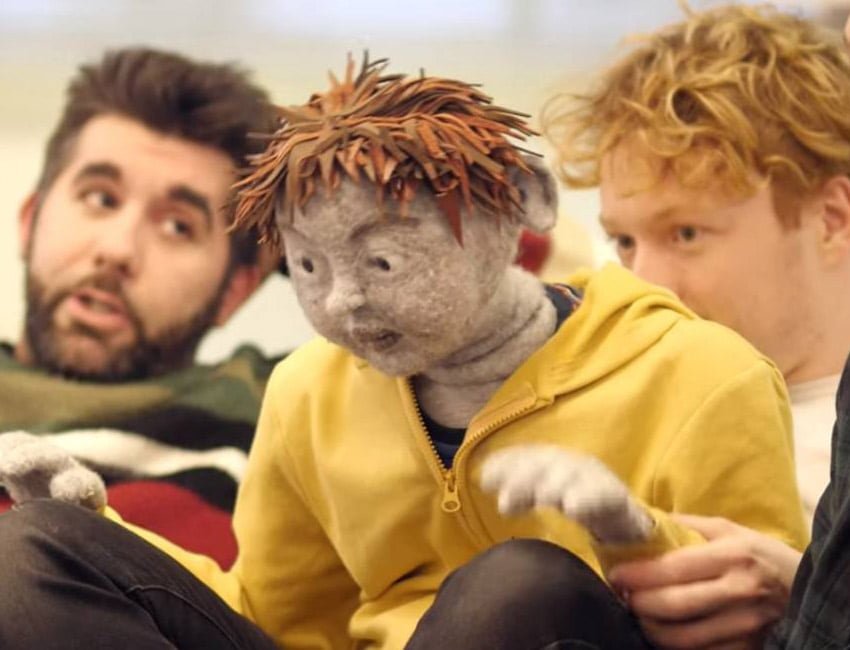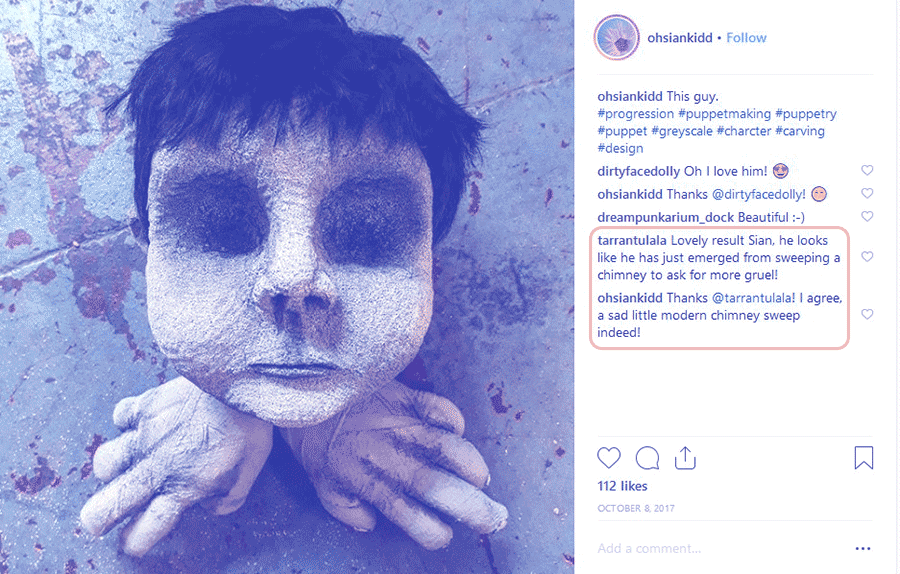You might be wondering what the creepy image above has to do with autism representation. Its connection to autism and the meaning of this image—as well as its potential consequences—will become clear later in this post.
All in a Row
You might have heard of the play All in a Row by English playwright Alex Oates, about the struggles of a family with their autistic child.

A lot of autistic people are offended by the play’s representation of autism, and the fact that the creators of the show don’t seem to listen to the feedback of the autism community. To what extent that is true or false, I will cover later in this post.
But first, here is the official synopsis of the play:
Like any couple, Tamora and Martin have big hopes and dreams. But when your child is autistic, non-verbal, and occasionally violent, ambitions can quickly become a pipe dream.
In a household brimming with love, resentment and realisations, meet Tam, Martin and Laurence’s carer Gary as they struggle to care for their beloved boy. On the night before social services finally intervenes, who is the victim here? Who was the traitor? And who do you blame when you can no longer cope?[1]All in a Row | Southwark Playhouse
That doesn’t sound like the most favorable representation of autism, but is it a fair one? A lot of autistic people argue it’s not. Let me first explain the (perceived) issue, and what this means for autism representation and awareness.
Dehumanization?
One big issue that the autistic community identified is that the autistic child in the play is represented by a puppet, unlike the parents and carer, and as such rather than the child being the subject of the play, he—quite literally—becomes the object.
Performing the whole play with puppets might have been a logical continuation of the kind of autism awareness mediated by puppets as seen in Sesame Street, with their autistic puppet Julia which premiered on the show in 2017. It might have sparked some important discussion, but instead, in the words of disability researcher and autism advocate Gill Loomes:
They literally dehumanised the identity they sought to represent.[2]Critics say new play that uses a puppet to portray an autistic boy ’dehumanises’ those with the condition | Evening Standard
One pre-show reviewer, Jo Wiggins Annand, stated:
I too was intrigued to see what my thoughts were on the puppet Laurence but I can honestly say that once the play had started, the focus wasn’t on him.[3]‘All in a Row’ Review | Anna Kennedy Online
and;
It was refreshing to see a play from the prospective [sic] of a mum, dad and carer who, may I add, did a superb job in portraying the roles.[4]‘All in a Row’ Review | Anna Kennedy Online
Of course it’s great to read that the family is portrayed well, but these two statements seem to emphasize the issue as autistic people see it: the focus is not on the autistic child; it’s on his parents’ and caretaker’s struggles.
This may be a valid narrative, but it does reflect badly on autism as a whole. As such, autistic people are rightly concerned about the show. And not just autistic people; the UK’s leading autism charity, the National Autistic Society, has even made the following public statement on Twitter:
About 700,000 people in the UK are autistic and most feel very misunderstood by the public. That’s why we give advice to production companies about ideas and scripts for TV, film and theatre to help them promote accurate images of autistic people.
The production company behind this play contacted us and we arranged for autistic and non-autistic people to give feedback. We are pleased the production company made two changes in response—one for accuracy and another around representation.
However, while recognising some of the play’s strengths, we decided we could not support the play overall due to its portrayal of autism, particularly the use of a puppet to depict the autistic character alone.[5]National Autistic Society | Twitter
The puppet
So there seem to be representational issues with the puppet. The creators of the play argue that the puppet is necessary because the kind of behavior (i.e. violence, such as biting) presented by the autistic child would not look favorably when portrayed by a child actor. A spokesperson further stated:
We don’t think we could get informed consent from a non-verbal autistic actor aged 11 to play the role and additionally due to the law around employing children we’d need to actually have a minimum of three child actors for the role, as well as specialist, trained and licensed chaperones present at each performance.[6]Critics say new play that uses a puppet to portray an autistic boy ’dehumanises’ those with the condition | Evening Standard
A child actor may indeed pose certain challenges, but it’s far from undoable (how many plays have included children?). But regarding the use of violence, it seems dubious to present a narrative of a “difficult” autistic child on the one hand, but to a degree censor the very attributes it is meant to represent. Maybe we do require a puppet to make the subject matter and certain violence palatable? It’s a fair question, and I hope future research will emerge from this controversy, so we can better approach certain subjects in the future.
Suppose a puppet is indeed required, and is conceptually, representationally, and ethically completely justified. Why is the puppet gray?

The aesthetics of the puppet arguably has a certain charm, but its gray skin is in stark contrast with the—unarguably more—human supporting characters, which makes me wonder if using a puppet to represent an autistic child wasn’t stark contrast enough.
The creators of the play suggest there is a conceptual reason for its skin color, and while I trust that it will make sense at some point of the show, without its proper context, we ought to be concerned with the representational influence it has—now, pre-show, but also for those who won’t see the play. And in light of the controversy and the representational issues, many people have decided not to watch the play.*
- On the other hand, many people might decide to watch the play to see what the controversy is all about.
Another disability researcher, Kim Sauder, found the account of the puppet maker’s first rendition of Laurence:[7]The puppet maker | Kim Sauder | Twitter

So now you understand what the eerie image at the top of this post is about. This ghost-like, necrotic looking child is what was meant to represent an autistic child. Note also the statement of the puppet maker (Siân Kidd):
A sad little modern chimney sweep indeed!
In my opinion, at least some of the people involved in this play don’t seem to treat the subject matter of the show with the kind of respect and care it deserves.
Autism advocate and Autism’s Got Talent creator, Anna Kennedy, states that we ought to reserve judgments until we have seen the play, and although that is fair, the consequences of the play’s concepts, execution, and engagement with the community go far beyond the actual play and its premiere, and she seems to overlook most of the issues around representation in her pre-show review of the play.[8]‘All in a Row’ Review | Anna Kennedy Online
I don’t think the creators of the play anticipated most of these issues, but the amount of damage these kinds of representational issues can do can be quite severe, so perhaps the creators should have trod more carefully. Fortunately, it brought autism representation up for a broader discussion, but along with it, it has made a lot of autistic people feel upset and unheard. You can bet there have been meltdowns and shutdowns over this!
Another perspective
Now that I have informed you about All in a Row from the perspective of autistic people, let me offer you a different perspective. A mother of an autistic child stated:
It would have been a very sad and scary day for young people like my son and their families, if this play hadn’t gone ahead. It would have effectively given the message that yp like my son , aren’t a fit subject for the public, and hidden away as in the past.[9]Not a fit subject | Jackie | Twitter
and;
I am getting tired of deliberately not watching / reading depictions of autism on/ in the media, as they bear little resemblance to my son. Tired of having to emphasise his difficulties, where once, just saying “autistic” was enough. Ironic, when his level needs most help.[10]Irony | Jackie | Twitter
I didn’t consider this perspective before, but I think it’s valid. There is another side to autism that is not presented in TV series and movies, but which equally seeks representation. There are many parents whose autistic children seem much closer to what the play attempts to present, and these parents seem to resonate strongly with the concept of the play.
As such, the show is perhaps not so easily discounted as mere ableism. That is not to say that there aren’t a lot of issues around this play—certainly perceived issues, which are arguably issues all the same—but there are issues around autism representation that transcend the play both in scope and responsibility.
Representation crisis
It also made me realize that a lot of autistic people are offended by the show on account of unfair representation. Arguably it is not us that the play attempts to represent, but rather the high support needs end of the autistic spectrum. But then it seems we have a representation crisis, because the representation of autism on one end of the spectrum—or rather, one of many spectra—apparently comes at the cost of representation of autism at the other end.
Saying one end of the spectrum needs more help is curious though, when the suicide rate on the other end is so high. Here are some frightening statistics:[11]Risk markers for suicidality in autistic adults
- 66% of autistics without language delay or intellectual disability (i.e. those historically designated Asperger syndrome or high-functioning autism) had contemplated suicide, compared to 17% in the general public.[12]Suicidal ideation and suicide plans or attempts in adults with Asperger’s syndrome attending a specialist diagnostic clinic: a clinical cohort study (Cassidy, 2014)
- 7–47% of us have attempted suicide, and we are more likely to succeed in our suicide attempt than neurotypicals.[13]Systematic Review of Suicide in Autism Spectrum Disorder: Current Trends and Implications (Hedley & Mirko Uljarević, 2018)[14]Suicidal ideation and suicide plans or attempts in adults with Asperger’s syndrome attending a specialist diagnostic clinic: a clinical cohort study (Cassidy, 2014)[15]Anxiety, Depression, and the Interpersonal Theory of Suicide in a Community Sample of Adults with Autism Spectrum Disorder (Dow et al., 2019)
- We are 800 times(!) more likely to die of suicide compared to the general public.
For more information on autism and suicide, have a look at the post below.
Autism & suicidality
It should be noted, however, that exactly because autism constitutes a constellation of traits governed by a multidimensional spectrum[16]Three spectrums, not one, may define autism | Spectrum (of support needs, sensory sensitivity, cognitive ability, etc.), there is no clear distinction between the two ends, but rather a smooth transition between the two ends of whatever spectrum you look at. Autistics and parents of autistic children alike seem to resonate with or be repelled from the very concept of the play, in part based on where they—or their child—find themselves on the spectrum of support needs. So what is the solution?
Representation shift
For many years the focus has been on classical autism, and a lot of funding and programs have emerged to help those with high support needs. The reason Natalie and I started Embrace ASD in the first place is because we felt autistic people with lower support needs are often overlooked. Yet just because we experience a greater amount of autonomy and even success in our careers, it’s a fallacy that we don’t need help on account of our lesser support needs. I think the statistics on suicide strongly indicate that we require help—and fair representation—all the same.
So now that autism without intellectual disability has come to the attention of the public, parents of autistic children that require more substantial support feel they are no longer represented by the media. It seems there has been a shift in representation of autism from one end of the spectrum to the other end.
This also makes me wonder whether the play All in a Row is supposed to listen to the feedback of autistic people with low support needs in the first place, because it seems the play is not about us. At the same time, their representation seems to undermine the public’s perception of autism with low support needs, and might generally confuse/distort the public perception of autism as a whole.
Narratives
At the low end of the spectrum, it seems it’s mainly the parents that are tormented by failures in representation of their autistic child, while on the higher end of the spectrum it’s us autistic people. Maybe not even that, because autistic children turn into autistic adults, who may endure a shift from one part of the autistic spectrum to another.
Regardless, neither narrative should take precedence over the other; both perspectives are valid and important, and issues around representation ought to be addressed on both sides of the spectrum—or indeed spectra.
Autism categories
I think this is one of the unforeseen issues with merging all autism categories into one. It confuses not only the public perception of autism, but apparently also autistic people themselves, as we now find ourselves fighting for fair representation by organizations that arguably weren’t trying to represent us in the first place—all the while identifying with the very broad and rather ambiguous term, autism.
Due to the merging of categories and the effective increase in ambiguity, it has become more challenging to get public awareness of our condition without potentially undermining public perception of the other part of the spectrum.
It seems thus we have not only a representation crisis, but a communication crisis. How can we get fair representation and public awareness when it’s not even clear which people correspond to which terms? How can we claim our identity, when others with a very different presentation of autism want to claim that very identity? How can we communicate without impinging on the representation and public awareness of those who find themselves on a different part of the autism spectrum?
I think we may need to rethink the different autism (sub)categories, because the ambiguity inherent to the current categorization makes it difficult for us to claim our identity or seek representation.
Addendum
I received a comment by Erik Copper on Facebook which I think is quite fair, so I decided to include it in this post:
As a performer with Autism, I think the reasoning behind them casting a puppet to play the Autistic character seems dehumanizing on a surface level, but if you look deeper, it’s completely understandable. Sure, plays have used children before, but non-verbal Autistic children require a different set of skills than most children. That’s not to say it CAN’T be done (I also work as a buddy/performer in an organization specifically for performers with special needs), but in a professional and public setting, the pressures can be very real and overwhelming.
That being said, the design of the puppet is VERY questionable. The inhuman skin color and the overall look can VERY easily be seen as offensive. Artistic freedom aside, there are much better ways to portray that type of character and this seems like a dubious attempt at it.[17]Representing autism | Asperger Syndrome Awareness | Facebook
And here is my response:
I agree that a puppet could be justifiable in principle. However a lot of autistic people are quite upset that not more autistic people have been included in the production of an entity that apparently seeks to represent them, which may itself be taken as an act of dehumanization.
It has been suggested that perhaps an adult should have played the part. Thinking about it again though, the use of a puppet may contribute a certain “magic” to the show that a human playing the part would have a hard time doing. Maybe in a play it’s easier to feel empathetic towards a puppet (provided it’s done well) than a human. I might derive more comfort from that.
I wish I had more insights and answers. Here the play could have done a better job by engaging the community in discussion, but most of their answers strike me as defensive, more so than curious about the subject they want to represent. Maybe it’s more about Alex Oates presenting his perspective than it’s about the voices of autism.Maybe that is a fair narrative as well. I still have concerns about how it reflects onto the public though.[18]Representing autism | Asperger Syndrome Awareness | Facebook
Comments
Let us know what you think!